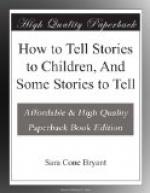“Here in the bank,” said the little brother; “water’s in it.”
“What!” said Hans, and he slid down as fast as he could to where his brother was playing.
There was the tiniest little hole in the bank. Just an air-hole. A drop of water bubbled slowly through.
“It is a hole in the dike!” cried Hans. “What shall we do?”
He looked all round; not a person or a house in sight. He looked at the hole; the little drops oozed steadily through; he knew that the water would soon break a great gap, because that tiny hole gave it a chance. The town was so far away—if they ran for help it would be too late; what should he do? Once more he looked; the hole was larger, now, and the water was trickling.
Suddenly a thought came to Hans. He stuck his little forefinger right into the hole, where it fitted tight; and he said to his little brother, “Run, Dieting! Go to the town and tell the men there’s a hole in the dike. Tell them I will keep it stopped till they get here.”
The little brother knew by Hans’ face that something very serious was the matter, and he started for the town, as fast as his legs could run. Hans, kneeling with his finger in the hole, watched him grow smaller and smaller as he got farther away.
Soon he was as small as a chicken; then he was only a speck; then he was out of sight. Hans was alone, his finger tight in the bank.
He could hear the water, slap, slap, slap, on the stones; and deep down under the slapping was a gurgling, rumbling sound. It seemed very near.
By-and-by, his hand began to feel numb. He rubbed it with the other hand; but it got colder and more numb, colder and more numb, every minute. He looked to see if the men were coming; the road was bare as far as he could see. Then the cold began creeping, creeping, up his arm; first his wrist, then his arm to the elbow, then his arm to the shoulder; how cold it was! And soon it began to ache. Ugly little cramp-pains streamed up his finger, up his palm, up his arm, till they reached into his shoulder, and down the back of his neck. It seemed hours since the little brother went away. He felt very lonely, and the hurt in his arm grew and grew. He watched the road with all his eyes, but no one came in sight. Then he leaned his head against the dike, to rest his shoulder.
As his ear touched the dike, he heard the voice of the great sea, murmuring. The sound seemed to say,—
“I am the great sea. No one can stand against me. What are you, a little child, that you try to keep me out? Beware! Beware!”
Hans’ heart beat in heavy knocks. Would they never come? He was frightened.
And the water went on beating at the wall, and murmuring, “I will come through, I will come through, I will get you, I will get you, run—run—before I come through!”
Hans started to pull out his finger; he was so frightened that he felt as if he must run for ever. But that minute he remembered how much depended on him; if he pulled out his finger, the water would surely make the hole bigger, and at last break down the dike, and the sea would come in on all the land and houses. He set his teeth, and stuck his finger tighter than ever.




